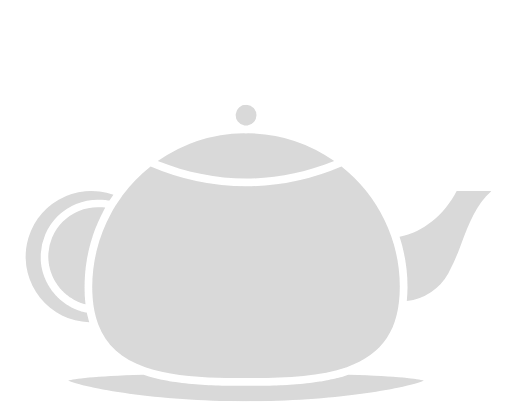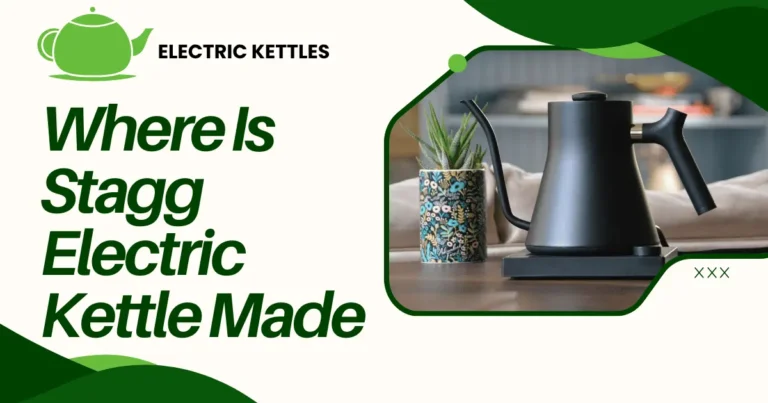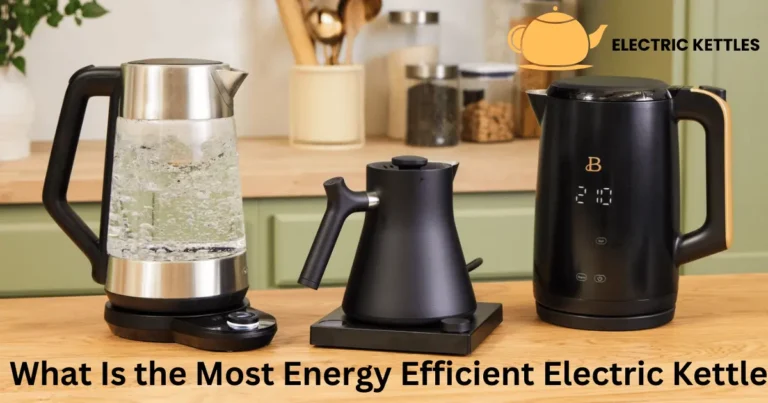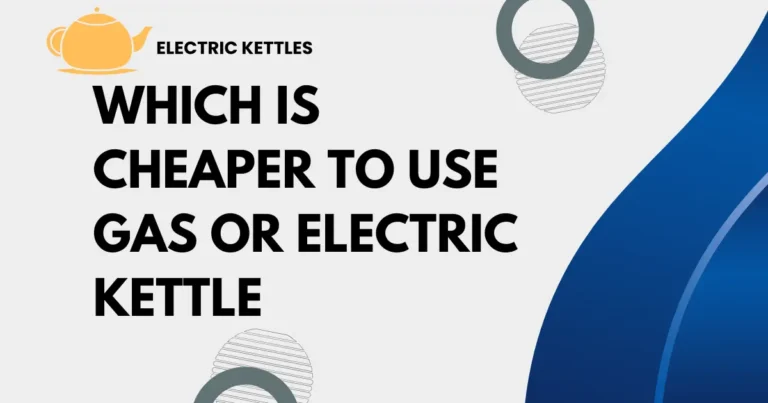How Hot Does an Electric Tea Kettle Get
Electric tea kettles are convenient appliances used to boil water quickly. They are faster than stovetop kettles and often come with features like automatic shut-off. These kettles are available in various sizes and designs. Many models also allow you to choose the desired temperature. This is important for brewing different types of tea.
Different teas need specific water temperatures to release their best flavors. For example, green tea is best brewed at lower temperatures, while black tea requires hotter water. Using the right temperature helps avoid bitter or flat-tasting tea. Electric kettles with precise temperature settings make it easy to achieve the right heat for each tea type.
Table of Contents
How Electric Tea Kettles Work
Electric tea kettles operate using a simple and efficient mechanism. When you plug in the kettle and switch it on, electricity flows through a heating element, usually located at the base of the kettle. This element generates heat, which warms the water inside the kettle. Most electric kettles have an automatic shut-off feature that activates once the water reaches a rolling boil, preventing overheating and ensuring safety.
The design of electric kettles often includes a thermostat that helps regulate the temperature. Some advanced models allow users to set specific temperatures for different types of tea. The kettle will heat the water to the chosen temperature and maintain it for a short time. This functionality enhances the brewing process, ensuring that the water is just right for your favorite tea, improving the overall flavor and aroma of the beverage.
Temperature Ranges of Electric Tea Kettles
Electric tea kettles come with a variety of temperature settings, allowing users to brew different types of tea at optimal temperatures.
Common Temperature Settings
Most electric tea kettles have preset temperature options that cater to various types of tea.
- 160°F to 185°F (70°C to 85°C): Ideal for delicate green and white teas, which can become bitter if brewed at higher temperatures.
- 185°F to 200°F (85°C to 93°C): Suitable for oolong teas, which benefit from a slightly higher heat to release their complex flavors.
- 200°F to 212°F (93°C to 100°C): Perfect for black teas and herbal infusions, as these require boiling water for optimal flavor extraction.
Precision Temperature Control
High-end electric kettles offer precise temperature control, allowing users to select specific temperatures within the above ranges. This feature is especially beneficial for tea enthusiasts who want to achieve the perfect brew. Some models allow adjustments in 1°F or 5°F increments, providing versatility for different tea varieties.
Factors Affecting Temperature Accuracy
Several factors can influence how accurately an electric kettle reaches the desired temperature.
- Altitude: At higher altitudes, water boils at lower temperatures, which may require adjustments in brewing practices.
- Kettle Design: The materials used in the kettle can affect heat retention and distribution. Stainless steel, for example, may heat more evenly than plastic.
- Water Quality: Mineral content and temperature of the water used can also impact the overall brewing process.
Safety Considerations
When using electric tea kettles, safety should be a top priority. These appliances are designed with various features to minimize risks associated with high temperatures and boiling water.
Risks of High Temperatures
Electric tea kettles can reach very high temperatures, which pose potential hazards. Boiling water can cause severe burns if spilled or splashed. It’s essential to handle the kettle with care, especially when it is full or just after boiling. Always use the kettle’s handle, as the body can become extremely hot during operation. Avoid touching the metal surfaces and ensure that children or pets are kept at a safe distance when the kettle is in use.
Automatic Shut-Off Features
Most modern electric kettles come equipped with an automatic shut-off feature. This safety mechanism activates once the water reaches a rolling boil or if the kettle is empty. This prevents overheating, which can damage the kettle and reduce the risk of fire hazards. Always check that this feature is functioning properly before use.
Material Safety in Kettles
The materials used in the construction of electric kettles also affect safety. Look for kettles made from food-grade materials, such as stainless steel or BPA-free plastic. These materials are less likely to leach harmful chemicals into the water, especially when heated. Regularly inspect the kettle for any signs of wear or damage, as cracks or deteriorating materials can compromise safety.
Recommended Practices for Safe Use
- Always fill the kettle to the recommended level to prevent boiling dry.
- Unplug the kettle after use and allow it to cool down before cleaning.
- Avoid placing the kettle near the edge of countertops to prevent accidental tipping.
- Regularly clean the kettle to prevent mineral buildup, which can affect its performance and safety features.
Maintenance and Care
Proper maintenance and care of electric tea kettles can extend their lifespan and ensure optimal performance.
Regular Cleaning
Cleaning your electric tea kettle is essential to remove mineral buildup and prevent unpleasant tastes in your water.
- Descaling: Use a mixture of equal parts water and vinegar or lemon juice to descale your kettle. Fill it to the maximum level, boil the mixture, and let it sit for about 30 minutes. Rinse thoroughly with fresh water afterward.
- Exterior Cleaning: Wipe the exterior with a damp cloth to remove stains or spills. Avoid using harsh chemicals or abrasive cleaners, as they can damage the surface.
- Cleaning the Spout and Filter: Remove any detachable parts, such as filters, and clean them regularly to ensure optimal water flow. Soak them in a vinegar solution if there is significant buildup.
Periodic Deep Cleaning
In addition to regular cleaning, it’s essential to perform a deeper clean occasionally.
- Inside the Kettle: If you notice a persistent taste or odor, try boiling a solution of baking soda and water. This can help neutralize any unwanted flavors.
- Checking for Wear: Inspect the kettle regularly for signs of wear, such as cracks or discoloration. If you notice any damage, consider replacing the kettle for safety reasons.
Proper Storage
Storing your electric tea kettle correctly can also enhance its longevity.
- Keep It Dry: After cleaning, ensure the kettle is thoroughly dry before storing it to prevent mold or mildew.
- Avoid Overheating: Do not place the kettle on hot surfaces or expose it to direct sunlight for prolonged periods.
- Use the Right Power Source: Always use the kettle on a flat, stable surface and ensure the cord is not frayed or damaged.
Troubleshooting Common Issues
If your kettle isn’t functioning properly, here are a few common issues and solutions.
- Not Boiling: Check if the kettle is plugged in and the automatic shut-off feature isn’t engaged. Ensure the kettle isn’t empty, as it may not heat if there’s insufficient water.
- Slow Heating: If the kettle takes longer to boil, it may need descaling. Mineral buildup can affect heating efficiency.
- Unpleasant Odors or Tastes: If you notice strange odors or tastes, ensure the kettle is clean and free of any residues.
Conclusion
How hot an electric tea kettle gets is important for making great tea. These kettles typically heat water to various temperatures, depending on the type of tea you are brewing. Using the right temperature helps unlock the full flavor of the tea, whether it’s delicate green tea or robust black tea. Knowing these temperature ranges ensures you can enjoy the best taste from your favorite brews.
Safety is also a key factor when using electric tea kettles. Features like automatic shut-off help prevent overheating and reduce risks. Regular maintenance, such as cleaning and descaling, keeps the kettle in good shape and ensures it heats water efficiently. By following the right practices, you can enjoy a safe and satisfying tea experience.






